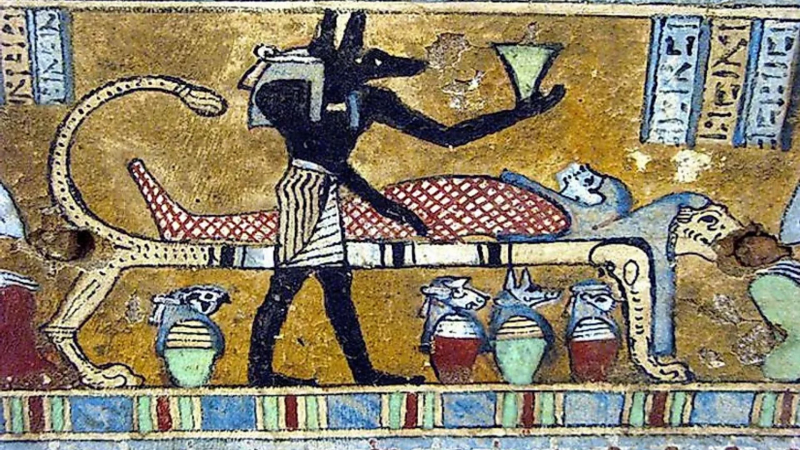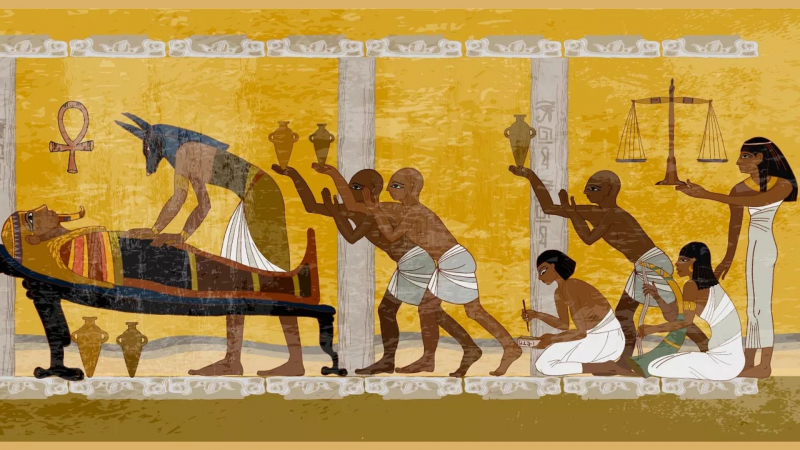Mummification
Mummification describes the techniques the ancient Egyptians employed to treat or embalm a corpse. The Egyptians used unique techniques to completely dry out the body, leaving behind a dried form that would not quickly decompose. Their faith stressed the importance of keeping the corpse as lifelike as possible. They were so prosperous that, three thousand years later, we can look at an Egyptian's mummified body and get a fair picture of how they appeared in life.
Mummification was practiced for the majority of Egyptian history. The earliest prehistoric mummies were most likely unintentional. Because Egypt has almost no measurable rainfall, dry sand and air preserved some bodies buried in shallow trenches excavated into the sand. Egyptians most likely began actively mummifying the deceased around 2600 BCE, during the Fourth and Fifth Dynasties. The practice persisted and evolved for nearly 2,000 years, well into the Roman period (ca. 30 BCE–CE 364). The quality of mummification varied over time, depending on the amount paid for it. Mummies from the Eighteenth through Twentieth Dynasties of the New Kingdom (ca. 1570-1075 BCE) are the best prepared and preserved and include Tutankhamen and other well-known pharaohs. Here, the overall course of this time period will be described.
The process of mummification takes seventy days. Special priests handled and dressed the body as embalmers. The priests required a thorough understanding of human anatomy in addition to knowing the proper rites and prayers to be said at different times. All internal components that might degrade quickly were removed as the initial step in the procedure. The brain was extracted by delicately pulling out pieces of brain tissue with special hooked devices that were inserted up through the nose. It was a delicate procedure that might easily leave the face disfigured. The abdominal and chest organs were then removed by the embalmers using a cut that was often performed on the left side of the abdomen. They only left the heart in place because they believed it was the center of a person's being and intelligence. The stomach, liver, lungs, and intestines were stored individually in special boxes or jars known today as canopic jars. These were interred alongside the mummy. Organs were treated, wrapped, and replaced within the body in subsequent mummies. Even yet, unused canopic jars were still used in the funeral process.
Following that, the embalmers eliminated all moisture from the body. This was accomplished by covering the body with natron, a form of salt with excellent drying characteristics, and inserting additional natron packets within the body. After the body had completely dried out, embalmers removed the inside packets and gently rinsed the natron off the body. As a result, a severely dried-out but recognizable human figure resulted. Sunken portions of the corpse were covered in linen and other materials, and artificial eyes were placed to make the mummy appear more lifelike.
Then the wrapping started. Several hundred yards of linen were required for each mummy. Long strips of linen were painstakingly twisted around the body by the priests, who occasionally wrapped each finger and toe individually before encircling the entire hand or foot. Amulets were interspersed with wrappings, and some of the linen strips had prayers and mystical writing on them to protect the dead from misfortune. Between the layers of headbands, the priests frequently inserted a mask of the person's face. The form was covered with warm resin at various points, and wrapping resumed. The priests finally placed the last shroud in place and fastened it with linen strips. The mummy had been finished. During this period, the priests who were preparing the mummy were not the only ones who were active. Although tomb preparation had normally begun long before the person's death, there was now a deadline, and craftsmen, laborers, and artists had to work rapidly. There was a lot of stuff to put in the tomb that a person would require in the hereafter. Furniture and statuettes were made; wall paintings of religious or daily subjects were completed, and meal or prayer lists were completed. When needed in the Afterlife, these models, photos, and lists would become real through a miraculous procedure. Everything had been prepared for the funeral.
Priests performed special religious procedures at the tomb's entrance as part of the funeral. The most essential aspect of the ceremony was known as the "Opening of the Mouth," in which a priest used a special instrument to "open" certain sections of the mummies to the senses enjoyed in life and required in the Afterlife. The deceased individual might now speak and eat by touching the gadget to his or her mouth. He was finally prepared to embark on his voyage to the Afterlife. The mummy was placed in his or her coffin(s) in the burial room, and the entrance was sealed.
Such elaborate burial traditions may indicate that the Egyptians were preoccupied with death. Because of their enormous love of life, they began making provisions for their death early on. They could think of no finer life than the one they were living, and they wanted to ensure that it would continue after death.
But why preserve the body, exactly? The mummified body, in the eyes of the Egyptians, served as the dwelling place for this soul or spirit. The spirit might be lost if the body were to be destroyed. Three spirits - the ka, ba, and akh - make up the complicated concept of "spirit." The sacrifices and items were needed at the tomb because the ka, a "double" of the deceased, would stay there. The ba, or "soul," had free rein to leave and enter the tomb. And the entity that had to pass through the Underworld to reach the Final Judgment and entry to the Afterlife was the akh, which is likely best translated as "spirit." All three were crucial to the Egyptians.
Egyptian pharaohs were frequently mummified and buried in ornate tombs after death. Members of the nobility and officials, as well as commoners, were frequently subjected to the same treatment. However, the procedure was prohibitively pricey for many people. Some animals were also mummified for religious reasons. The early dynasties' sacred bulls had their own graveyard in Sakkara. Baboons, cats, birds, and crocodiles, which had sacred importance as well, were sometimes mummified, particularly in the latter dynasties.

















